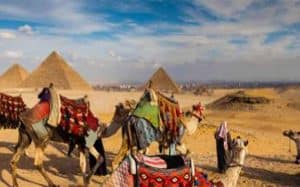The World’s Most Isolated Tribes: Navigating the Ethics of Cultural Encounters

Updated On: April 17, 2024 by Eman Sameh
As the world grows increasingly interconnected, the existence of isolated tribes invites a complex web of ethical questions regarding our interactions with them. Isolated and uncontacted tribes, with their distinct cultures and ways of life, provide a glimpse into human societies that have evolved in parallel to our own, yet with minimal or no influence from the global community. These groups, often found in remote regions of the Amazon rainforest, the islands of the Andaman Sea, or the dense forests of New Guinea, stand as testaments to a diverse human legacy.

Understanding the delicate balance between respecting the autonomy of these indigenous communities and the curiosity to learn from them is key to addressing the ethics of visiting them. Each encounter between the outside world and an uncontacted tribe carries potential risks, not just of cultural disruption but also of introducing diseases to which the tribes have no immunity. The ethical considerations of such interactions are as much about protecting these communities from external harm as they are about preserving their right to remain uncontacted.
Historical Context of Isolated Tribes
In our quest to understand the fabric of human society, the historical context surrounding isolated tribes reveals much about the evolution of anthropology, the respect for indigenous peoples, and the ethics of exploration in the face of modern civilisation.
Early Discoveries and Studies
The study of isolated tribes first gained momentum as European explorers expanded their horizons and encountered indigenous peoples during their voyages. Such discoveries often led to the early anthropologists documenting distinct cultures and societies that had developed independently of what was known as modern civilisation. These anthropologists meticulously recorded their ways of life, from the minutiae of daily activities to overarching societal structures.
Changes in Perception Over Time
As exploration continued, our collective understanding deepened, and the perception of these tribes shifted significantly. Initially seen as curiosities, there has been a growing recognition of their right to remain undisturbed. This recognition correlates with changes in how anthropologists and modern civilisation view indigenous peoples. Many communities that were once subjects of study are now regarded as equal custodians of humanity’s rich cultural tapestry. We now understand that our interactions with them must be handled with utmost respect, keeping their well-being and autonomy at the forefront.
Current Status of Isolated Tribes Worldwide
Isolated tribes worldwide represent some of Earth’s most understudied and least understood communities. Their status is a delicate blend of geographical seclusion and fading anonymity in the face of global interest.
Geographical Distribution
Isolated tribes are primarily found in dense forest regions and isolated islands, with significant populations in South America, New Guinea, and parts of India. In Brazil and Peru, vast expanses of the Amazon rainforest harbour several of these enigmatic communities. Meanwhile, the Andaman Islands in India are home to the Sentinelese, an isolated group with a reputation for rejecting external contact.
Population Estimates
Estimates suggest there might be more than 100 uncontacted tribes in existence, though exact numbers are inherently uncertain due to the challenges of assessing these secluded groups. In Brazil, for instance, it’s believed that there are more than 77 uncontacted tribes, while in New Guinea, the rugged terrain hides many undiscovered communities.
Ethical Considerations in Interactions

As we consider the delicate subject of the world’s most isolated tribes, it is imperative to scrutinise the moral complexities inherent in any form of interaction with them. The engagement with these communities isn’t merely about the act of visiting; it encapsulates a broader spectrum of ethical considerations that must be meticulously weighed.
Anthropological Perspectives
Anthropologists have long debated the ethical ramifications of interacting with isolated tribes. It is widely agreed that such interactions must prioritise the well-being and consent of these communities. The presence of outsiders, including researchers or missionaries, can bring about profound changes, often disruptive to the tribe’s way of life. When gifts are introduced to these communities, there is a tangible risk of altering indigenous cultures and creating dependencies.
Human Rights and Indigenous Sovereignty
Similarly, the lens of human rights and indigenous sovereignty sharpens the focus on these ethical considerations. Human rights organisations underscore the importance of respecting the self-determination and autonomy of isolated tribes. Indigenous sovereignty asserts that these groups have the right to govern themselves and make decisions about their land and way of life without undue influence or pressure from external entities.
In our interactions, whether through direct contact or policies affecting these tribes, our responsibility is to ensure that their rights are paramount. It is a complex issue, indeed, requiring a balance between offering protection and respecting independence.
Assessing the Impact of Outside Contact

When considering the effects, we must recognise that encounters with outsiders can have profound consequences for undescribed Amazonian indigenous people and their way of life.
Health and Immunity Challenges
The health of isolated tribes is particularly vulnerable to common diseases due to their lack of immunity. For example, introducing the flu virus or measles could prove devastating, as isolated indigenous societies lack the historical exposure necessary to develop resistance. Their isolation has preserved them in many ways, but it leaves them critically endangered in the face of such threats.
Cultural Disruption and Changes
The traditional lifestyle of these tribes can be drastically altered by outside contact. Cultural disruption often follows the intrusion of miners, loggers, and hunters despite government “protection”. These invasions not only threaten the tribes’ way of life but also risk undiscovered knowledge that has been maintained over generations.
Survival Strategies of Isolated Tribes
In our exploration of the world’s most isolated tribes, we observe that their survival hinges on finely honed strategies which are deeply enmeshed with their environment and resources.
Adaptation to Environment
Isolated tribes have developed sophisticated ways to live in harmony with their surroundings. For example, hunter-gatherers adapt to various climates by creating suitable shelters and clothing. They might cultivate extensive knowledge of plant cycles and animal behaviour in the forest to find shelter and forecast weather changes effectively. Their sensory skills are often highly attuned to the forest sounds and scents, enabling them to navigate and survive in dense wildernesses.
Utilisation of Natural Resources
These tribes’ use of resources epitomises sustainable living. Water sources are revered and conserved; often, tribes have elaborate customs and social practices revolving around the sharing and preservation of clean water. Tools such as bows and arrows are also crafted from available materials, demonstrating an intimate understanding of their environment. The process and materials used imbue these tools with resilience and efficacy, essential for hunting and protection.
Isolated tribes have much to teach us about resilience, sustainability, and the deep connection between humans and nature. By observing their practices, we better understand how to live in balance with the environment.
Organisations and Efforts to Protect Isolated Tribes
Dedicated organisations and governmental bodies worldwide are implementing measures and policies to safeguard the rights and territories of the world’s most isolated tribes. Their work is crucial to ensuring these communities can maintain their way of life free from external pressures and threats.
International Initiatives
Survival International is one of the leading global organisations advocating for the rights of indigenous peoples, including isolated tribes. They campaign against the forcible removal of tribal peoples from their land, providing them with a platform to speak to the world and lobbying international authorities to recognise and act on the human rights abuses they endure.
Governmental Policies
In Brazil, the National Indian Foundation, or FUNAI, is a federal agency committed to protecting the country’s indigenous populations, especially the uncontacted tribes in the Amazon rainforest. The FUNAI implements policies that create reserves and enforce the legal recognition of tribal territories, minimising the risk of conflicts with outsiders.
Equally, the Indian government has specific legal frameworks and enforcement mechanisms in place to protect their indigenous populations, such as the Sentinelese in the Andaman Islands. Crucially, laws prohibit anyone from approaching or contacting the tribes, thereby preserving their isolation and protecting them from diseases and cultural disruption.
Challenges Faced by Uncontacted Tribes

Uncontacted tribes worldwide face a series of critical challenges that threaten their existence and way of life. We aim to explore the intricacies of their situations, shedding light on the severity of these issues, including encroachment on their lands and the risks of violent interactions.
Encroachment and Resource Exploitation
Remote indigenous communities are increasingly threatened by external pressures, specifically from mining and logging activities that destroy their ancestral lands. For instance, in the Amazon rainforest, where many of these tribes reside, large swathes of land are being systematically cleared. Not only does this result in the loss of precious habitat, but it also exposes tribes to diseases to which they have no immunity. The devastation wrought by deforestation further disrupts the delicate ecological balance that these tribes rely on for survival.
Violent Conflicts with Outsiders
Interactions with the outside world can often lead to violence and threats to the very survival of uncontacted tribes. Several tribes have already experienced brutality, such as the dubious encounters that have pushed some tribes to retreat even deeper into isolation. History has shown that these confrontations are rarely beneficial to indigenous peoples and are often instigated by external parties seeking to exploit tribal lands for commercial gain. The Sentinelese tribe, for example, has remained particularly isolated, opting to aggressively defend their territory against any form of contact with outsiders.
Controversies Surrounding Isolated Tribes
Interactions between isolated tribes and the external world raise sensitive debates and ethical questions. Here, we expound on the ramifications of contact and portrayal.
Debates on Developmental Intervention
Developmental intervention debates often hinge on the rights of isolated tribes to self-determination versus the potential benefits of contact with the outside world. Proponents of non-intervention argue that contact, even if well-intentioned, can lead to catastrophic outcomes, including the spread of disease to which these tribes have no immunity. Conversely, arguments suggest that controlled contact could offer access to modern healthcare and education, potentially improving quality of life.
Media Representation and ‘Human Safaris’
Media representation is pivotal in shaping the public’s perception of isolated tribes. Instances such as National Geographic’s portrayal of indigenous peoples can influence public opinion, often romanticising or misrepresenting their ways of life. The phenomenon dubbed ‘human safaris’, where tourists intrude on indigenous lands for voyeuristic pleasure, continues to be a contentious issue. It disregards the dignity and autonomy of the tribes and can put both parties at risk of hostility or conflict.
Engaging with these controversies, we remain mindful of the delicate balance between respecting the autonomy of isolated tribes and the outside world’s natural curiosity.
Legal Framework and Indigenous Rights

In this section, we discuss the critical role both international laws and national policies play in protecting the rights of the world’s most isolated tribes.
International Law and Indigenous Protections
Internationally, indigenous rights are affirmed by many legal instruments that oblige governments to respect the sovereignty and territories of indigenous communities. A key document is the United Nations Declaration on the Rights of Indigenous Peoples (UNDRIP), adopted in 2007, which speaks to the right of indigenous peoples to self-determination and the protection of their cultural and land rights. Instruments such as ILO Convention 169 further elaborate on the rights of indigenous and tribal peoples in independent countries. These international frameworks underscore the collective rights of indigenous peoples, acknowledging their right to maintain and develop their cultural traditions and customs.
National Policies and Enforcement
At the national level, the enforcement of legal protections for indigenous communities often falls to domestic authorities and the police. Enforcement can be inconsistent, with the rights of indigenous peoples sometimes clashing with other national interests. Countries such as Brazil have established specific agencies to handle indigenous affairs tasked with legally protecting these communities and their territories. Nonetheless, there can be a significant gap between the laws as written and their actual implementation, with challenges stemming from insufficient resources, inadequate training of enforcement officials, and conflicting local interests.
Case Studies of Tribal Contact
In this section, we’ll explore two key examples of tribes that have remained largely isolated from the outside world: the Sentinelese of North Sentinel Island and the Pintupi Nine of Australia. These case studies provide valuable insights into the complexities and ethical considerations associated with contacting isolated tribes.
The Sentinelese of North Sentinel Island
The Sentinelese tribe, residing on North Sentinel Island in the Andaman archipelago, is considered one of the world’s most isolated groups. Their limited interaction with outsiders is exemplified by the extraordinary encounter of anthropologist Madhumala Chattopadhyay, who managed to achieve a peaceful exchange of floating coconuts towards the tribe. However, any contact with the Sentinelese poses significant risks, both in terms of potential violence and the introduction of diseases to which they have no immunity.
The Pintupi Nine of Australia
Drawing a parallel, the Pintupi Nine, a group of Indigenous Australians, remained secluded in the Gibson Desert until 1984, preserving their traditional nomadic lifestyle. Unlike the Sentinelese, their eventual contact with other Pintupi people led to a merging of traditional and contemporary lives. The account of the Pintupi Nine’s first contact reveals the diverse outcomes that can arise when isolated tribes encounter modern civilisation.
Our examination highlights the delicate nature of initiating contact with indigenous tribes. Contact must respect the autonomy and well-being of these communities, embracing a stance that prioritises their rights and the preservation of their unique cultures.
Moving Forward: Future Prospects and Conservation

As we consider the interaction with the world’s most isolated tribes, we recognise the importance of a sensitive approach that prioritises their vulnerability and the conservation of their unique way of life. We focus on developing strategies for sustainable interaction and enhancing educational and awareness efforts to ensure these communities can thrive in the modern world without sacrificing their cultural identity.
Strategies for Sustainable Interaction
- Respectful Engagement: Ensure all interactions with isolated tribes are led by respect for their autonomy and informed by their consent.
- Policy Development: Work with governments to establish policies that protect the rights and territories of isolated tribes from external pressures.
- Supporting Guardianship: Acknowledge and support the role of indigenous people in managing their environments through practical conservation efforts.
Within these strategies, we aim to both shield these tribes from external threats and empower them to manage their futures.
Educational and Awareness Efforts
- Global Campaigns: Launch global campaigns to raise awareness about the cultures and challenges facing isolated tribes.
- Collaborative Learning: Create learning programmes that involve the active participation of indigenous groups to share knowledge respectfully.
- Targeted Education: Tailor educational materials to specific audiences to foster a depth of understanding about the crucial role indigenous peoples play in biodiversity conservation.
Through our commitment to education and awareness, we champion the protection of vulnerable communities by informing our actions with a deep respect for their life choices.
Frequently Asked Questions

In exploring the ethical dimensions of interaction with the world’s most isolated tribes, we consider consent, impact, and preservation issues. These questions guide our understanding and shape our responsibilities as we contemplate the delicate balance between curiosity and respect.
What are the potential impacts of contacting isolated tribes?
Contact with isolated tribes can lead to cultural disruption and the spread of diseases to which these communities may have no immunity. Introducing modern technology and values can undermine their traditional ways of life, leading to social disintegration.
How do governments protect the rights and territories of uncontacted tribes?
Governments may enact laws to create protected reserves and enforce regulations that restrict access to the lands of uncontacted tribes. By recognising isolated communities’ sovereignty and land rights, they offer a buffer against external pressures.
What ethical considerations arise from photographing or documenting isolated tribes?
Documenting isolated tribes brings forth ethical dilemmas that hinge on consent and dignity. Respecting their privacy and avoiding portrayals that could lead to exploitation or misrepresentation are paramount.
How can we ensure the health and safety of isolated tribes during encounters?
Precautions must be taken to minimise health risks, such as following strict quarantine protocols before contact. It is crucial to have medical support on hand to address potential outbreaks of disease among these populations.
Why is it important to respect the autonomy of the world’s most isolated communities?
Respecting the autonomy of isolated tribes acknowledges their right to self-determination. It is a matter of human rights that these communities can decide how they want to live and whether they wish to engage with the outside world.
What are the challenges in preserving the cultures of the world’s most secluded tribes?
Preservation efforts are complex, as they must balance the tribes’ right to remain isolated with the need to protect them from external threats such as deforestation and illegal encroachment. Safeguarding their cultures requires sensitivity to their wishes and a commitment to protecting their environments.






